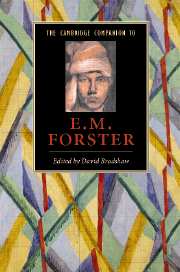Book contents
- Frontmatter
- Introduction
- 1 Forster’s life and life-writing
- 2 Bloomsbury and other values
- 3 Forster and England
- 4 Hellenism and the lure of Italy
- 5 Forster and the short story
- 6 Forster and the novel
- 7 Forsterian sexuality
- 8 Forster and women
- 9 A Room with a View
- 10 Howards End
- 11 Maurice
- 12 A Passage to India
- 13 Forster and modernism
- 14 Forster as literary critic
- 15 Filmed Forster
- 16 Postcolonial Forster
- Further reading
- Index
- Series List
9 - A Room with a View
Published online by Cambridge University Press: 28 September 2007
- Frontmatter
- Introduction
- 1 Forster’s life and life-writing
- 2 Bloomsbury and other values
- 3 Forster and England
- 4 Hellenism and the lure of Italy
- 5 Forster and the short story
- 6 Forster and the novel
- 7 Forsterian sexuality
- 8 Forster and women
- 9 A Room with a View
- 10 Howards End
- 11 Maurice
- 12 A Passage to India
- 13 Forster and modernism
- 14 Forster as literary critic
- 15 Filmed Forster
- 16 Postcolonial Forster
- Further reading
- Index
- Series List
Summary
What is the story? How does one tell it, understand it? Does one read it as one would a Jane Austen novel with the heroine Lucy Honeychurch, like EmmaWoodhouse or Elizabeth Bennet, coming to learn who she is and what she wants through false starts and confusions, both internal and imposed by society, finally rewarded by the right husband (not her mistaken first choice) at the end? That is certainly one way of reading the novel, and for many years following its 1908 publication, it was read as a cheerful Bildungsroman, its heroine's education unfolding as social comedy inflected by social satire, although marred in the eyes of some by too much whimsy or fantasy or sentimentality or downright eccentricity. But that story, even as it organises the plot, is not the whole story. Threaded through a comic tale of tourism and its discontents, built on the scaffolding of the standard marriage plot, is a darker, more complex, less end-determined narrative.
To a degree, that story was heard by the novel's early readers, but for the most part with puzzlement rather than pleasure. Why does Mr Emerson preach so much? What motivates the Reverend Beebe? Why is George so unrealised as a character? These questions recur through the century but from the publication of James McConkey's study in 1957 onwards, they more often become the means to enter Forster's novel with varying degrees of sympathy. They are seen less as pointing to flaws in the novel than as constituting its interest. This version of Forster's text tests its plot elements against a set of abstractions, utopic ideals, and beliefs about truth and passion, about comradeship and the call of the blood, rather than against the social conventions and public expectations of the realist novel.
- Type
- Chapter
- Information
- The Cambridge Companion to E. M. Forster , pp. 138 - 150Publisher: Cambridge University PressPrint publication year: 2007
- 2
- Cited by



